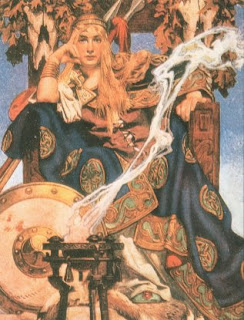




Here is some incerdible work by my amazing former student Jennifer Poon:
A resource for students and alumni of Illustration5 and the illustration program at California College of the Arts (formerly CCAC)






Question: Let the readers know what you job consist of? What sort of work does being an art direction consist of?
Irene: It's my job to get all of Tor's book jackets created. I juggle the concerns of the Editorial department and the Sales & Marketing department to try and come up with a jacket that everyone likes. It's a lot of management work, but I'm always working with creative people and ideas. There is a lot of illustration used in science fiction and fantasy and by far the most enjoyable part of my job is working with the illustrators.
Question: Where did you go to art school?
Irene: Cooper Union. I was very lucky. Foolishly, it was the only school I applied to. I wanted to go there because it was considered and excellent art school, located in downtown Manhattan, and free. Once there I took a typography class on a whim and found that I really loved the problem solving of design.
Question: Do you find yourself not being able to enjoy art because it is your job?
Irene: Not at all. In fact, if anything I enjoy it even more. I have a much more intimate reaction to art knowing some of issues these guys struggle with. I think things are even more magical when I have a little insight into how they are made and knowing how difficult it is to make something seem effortless.
What _is_ unfortunate is that between Tor and volunteering at the Society of Illustrators I don’t have the time to read as much as I used to. I skim the first handful of manuscript pages and then something else is overdue and needs attention.
Question: Do you have to go out and find new talent or does it find you.
Irene: Both. I spend a whole lot of time looking for artists -- in bookstores, annuals (like Spectrum), online forums (like Conceptart.org), conventions, magazines, wherever I can. When I see a book cover, I want to know who did it -- whether I like it or not, I want to know who’s out there and what they are doing.
I also get lots and lots of mail. When I first started I would get portfolio drops a few times a week, nowadays printing has become so cheap that people send me tons of postcards and other mailers. Sometimes I get unsolicited email but that is fairly intrusive. It might lead me to their website, but only if I am really trying to avoid work.
I find a surprising amount of artists through recommendations by other artists. It’s a very supportive and giving community.
Question: What does a normal mail day for Irene look like when you are in the office?
Irene: Normal? You know I work at Tor, right?
Actually, it is all terribly normal...just with more interesting people than your average office. Lots of meetings, lots of figuring out deadlines and then complaining when they are not met, tons of email with artists. Begging editors for information. Begging artists to meet deadlines. Slinking away from Sales when I don’t have a cover ready.
Question: Do you read the book?
Irene: We publish hundreds of books each year so, unfortunately, I cannot read them. I rely on a series of conversations with the editors to get a sense of the book. Author blogs are a big help to get a feeling for someone’s work. Once I feel like I have a handle on the tone of the book I’ll pick a few artists and then talk to the editor and see if I’m heading in the right direction. Some artists like to read the books, and that’s a big help. Sometimes an editor will talk about the most pivotal scenes that may not be the most visual.
Question: How hard is it to match the author's vision of a character to the book? What about the people that say that's not what the character looked like? What would you say is the best cover matching story artwork?
visit Fantasybookspot.com to read the rest of this interview


 "To Hans Christian Andersen paper was not meant to be media for the written word only. Paper - it seems - represented the basis for his imaginative expressing. Through out his life Hans Christian Andersen was an addict to paper. He wrote on it, he drew on it - and he used it to cut in. Like the ancient expression that he form and art was hidden in the stone, only to be revealed by the sculptor, the poet used his material - the paper - to engrave, or rather to carve out his ideas with ink. And more radically he used his unexpected monstrous scissors to cut out the most elegant figures.
"To Hans Christian Andersen paper was not meant to be media for the written word only. Paper - it seems - represented the basis for his imaginative expressing. Through out his life Hans Christian Andersen was an addict to paper. He wrote on it, he drew on it - and he used it to cut in. Like the ancient expression that he form and art was hidden in the stone, only to be revealed by the sculptor, the poet used his material - the paper - to engrave, or rather to carve out his ideas with ink. And more radically he used his unexpected monstrous scissors to cut out the most elegant figures.